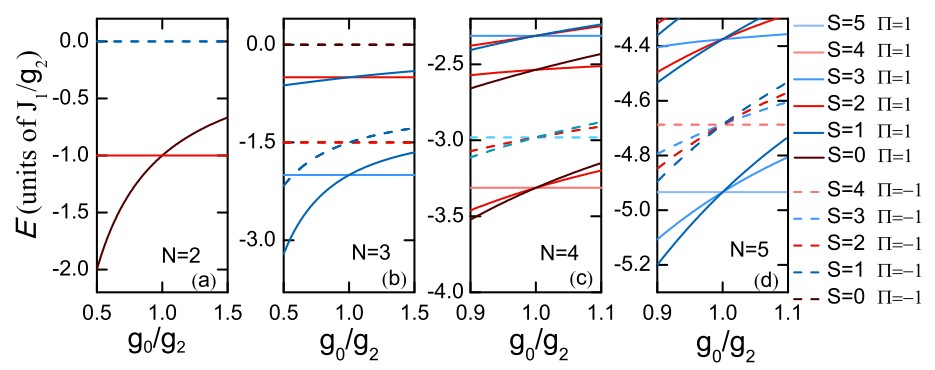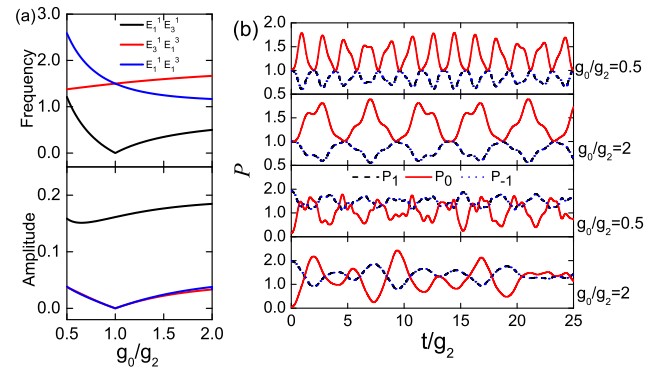
News
 Bethe-Ansatz专家管习文来我组作系列报告[2017-11-10]
Bethe-Ansatz专家管习文来我组作系列报告[2017-11-10] Topological Phase Transition and Charge Pumping in a One-Dimensional Periodically Driven Optical Lattice[2017-07-30]
Topological Phase Transition and Charge Pumping in a One-Dimensional Periodically Driven Optical Lattice[2017-07-30] 山西大学2017研究生毕业典礼[2017-06-25]
山西大学2017研究生毕业典礼[2017-06-25] CAT小组刘彦霞同学通过博士学位论文答辩[2017-06-03]
CAT小组刘彦霞同学通过博士学位论文答辩[2017-06-03] 王利CSC公派访学结束回所工作[2017-05-22]
王利CSC公派访学结束回所工作[2017-05-22] 尹相国回到冷原子理论研究组工作[2017-04-13]
尹相国回到冷原子理论研究组工作[2017-04-13] Spectroscopy and spin dynamics for strongly interacting few spinor bosons in one-dimensional traps[2017-04-06]
Spectroscopy and spin dynamics for strongly interacting few spinor bosons in one-dimensional traps[2017-04-06] Collective excitation of a trapped Bose-Einstein condensate with spin-orbit coupling [2017-03-16]
Collective excitation of a trapped Bose-Einstein condensate with spin-orbit coupling [2017-03-16] Quantum walks in the commensurate off-diagonal AAH model[2017-02-03]
Quantum walks in the commensurate off-diagonal AAH model[2017-02-03] 刘娜获得2016硕士国家奖学金[2017-01-12]
刘娜获得2016硕士国家奖学金[2017-01-12]Spectroscopy and spin dynamics for strongly interacting few spinor bosons in one-dimensional traps
Recently the experiment in Heidelberg showed strong evidences that the spin chain of few cold atoms in one-dimensional system without an underlying lattice can be realized in vicinity of a scattering resonance[1]. On the theoretical side, the general form of the effective spin-chain model for strongly interacting atomic gases with an arbitrary spin in the one-dimensional(1D) traps has been presented [2-8]. This provides a platform for the research of basic magnetic processes in few-body system. For the two-component system with a large but finite strong s-wave interaction, the transition between the ferromagnetism (FM) and anti-ferromagnetism (AFM) phase, the theorem on the level crossing between singlet ground state and the maximum spin state have been studied [9-11]. Due to the existence of two-channel interaction, the spin-1 system exhibits much richer phenomena than the two-component system, which is expected to give rise to rich magnetic properties in the strongly interacting limit.
Based on the effective spin-chain model to strongly interacting trapped boson gases with spin-1, we study the properties of the magnetic ground state in the strongly repulsive regime and explore the ordering and crossing of the energy levels when the interaction transfers from the FM to AFM(see fig1). By analyzing the symmetry of system in the presence of a spin-dependent magnetic gradient and a transverse magnetic field, we show how the ground state may be manipulated and the atoms would collide in the spin-mixing dynamics depending mainly on the ratio between of interaction strengths in the two collisional channel(see fig2).
This work has been accepted by Phys. Rev. A.

Fig.1

Fig.2
Reference:
[1] Deuretzbacher, G. Zürn, J. Bjerlin, S. M. Reimann, L. Santos, T. Lompe, and S. Jochim, Phys. Rev. Lett. 115, 215301 (2015).
[2] F. Deuretzbacher, K. Fredenhagen, D. Becker, K. Bongs, K. Sengstock, and D. Pfannkuche, Phys. Rev. Lett. 100, 160405 (2008).
[3] F. Deuretzbacher, D. Becker, J. Bjerlin, S. M. Reimann, and L. Santos, Phys. Rev. A 90, 013611 (2014).
[4] Lijun Yang and Xiaoling Cui, Phys. Rev. A 93, 013617 (2016).
[5] Li Yang, Limin Guan, and Han Pu, Phys. Rev. A 91, 043634 (2015).
[6] Li Yang and Han Pu, Phys. Rev. A 94, 033614 (2016).
[7] E. J. Lindgren, J. Rotureau, C. Forssen, A. G. Volosniev, and N. T. Zinner, New J. Phys. 16, 063003 (2014).
[8] A. G. Volosniev, D. Petrosyan, M. Valiente, D. V. Fedorov, A. S. Jensen, and N. T. Zinner, Phys. Rev. A 91, 023620 (2015).
[9] Xiaoling Cui and T.-L. Ho, Phys. Rev. A 89, 023611 (2014).
[10] E. H. Lieb and D. Mattis, Phys. Rev. 125, 164 (1962).
[11] L. Guan and S. Chen, Phys. Rev. Lett. 105, 175301 (2010); L. Guan, S. Chen, Y. Wang, and Z. Q. Ma, Phys. Rev. Lett. 102, 160402 (2009).
© 2004-2010 CAT@Shanxi University